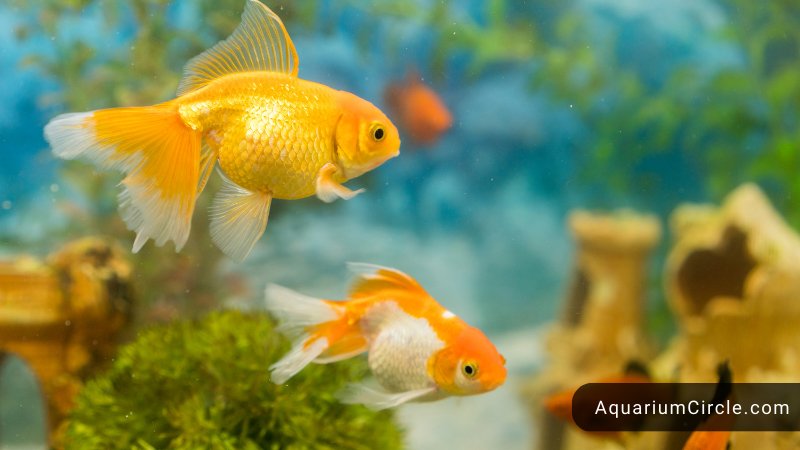If you’re a fish enthusiast looking for a beautiful and easy-to-care-for fish to add to your aquarium, consider the fantail goldfish. This popular breed of goldfish is known for its flowing fins and round body, and comes in a variety of colors. In this blog post, we’ll dive into everything you need to know about fantail goldfish, from their physical characteristics to their housing and care requirements, breeding habits, and common health issues. Plus, we’ll share some fun facts about these stunning fish that you may not have known. Whether you’re a seasoned fish owner or a first-time aquarium hobbyist, read on to discover why fantail goldfish are a great choice for any fish lover.
See also:
- Pink Oranda Goldfish: Top 7 Information That You Need To Know When Raising This Fish
- Black Moor Goldfish: Care Guide, Breeding, Lifespan,tank Size, Tank Mates And More
Definition Of Fantail Goldfish
First, let ‘s take a look at the definition so that we can know what a fantail goldfish is.
A fantail goldfish is a breed of domesticated goldfish that is known for its distinctive tail fin. The fantail goldfish has a round, egg-shaped body and a broad, fan-shaped tail that is held high and erect above its body. This fish is available in a wide range of colors, including red, orange, black, white, and calico, and its fins can be either single, double, or triple fans.
The fantail goldfish is a popular aquarium fish and is commonly kept in fish tanks, outdoor ponds, and other aquatic environments. It is a hardy and adaptable fish that is easy to care for, making it a good choice for both novice and experienced fish keepers. The fantail goldfish is a sociable and peaceful fish that can be kept with other cold-water fish, but it should be kept away from aggressive or fin-nipping fish.
Fantail goldfish are the result of selective breeding over many generations. This selective breeding has led to the development of a fish that is visually stunning and graceful in its movements. Fantail goldfish can live up to 10-15 years with proper care and maintenance, making them a long-term and rewarding pet for fish enthusiasts.
How important are fantail goldfish?
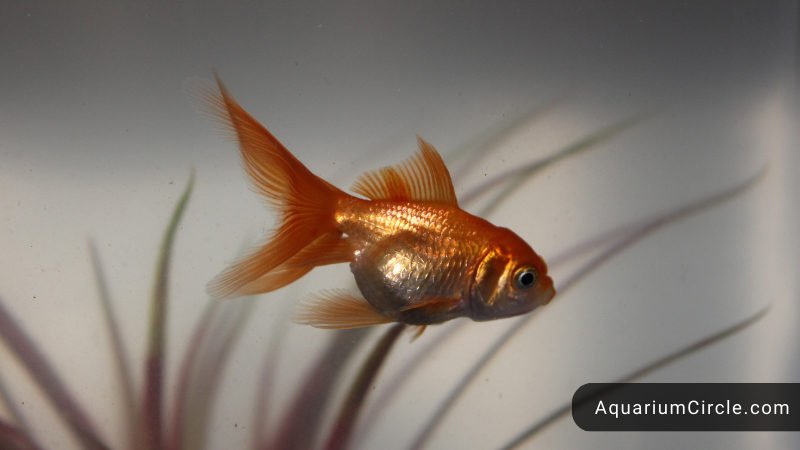
The importance of fantail goldfish can be viewed from a few different angles:
- As a domesticated pet: Fantail goldfish are an important pet for many people who enjoy caring for fish. They are popular among fish enthusiasts due to their unique appearance, gentle nature, and ease of care. For many people, owning a fantail goldfish can bring joy, relaxation, and a sense of responsibility.
- As a cultural symbol: Fantail goldfish have played a significant role in several cultures throughout history. In China, goldfish have been bred for ornamental purposes for over a thousand years, and they have been a symbol of good luck and fortune. In Japan, goldfish are popular in summer festivals and have been the subject of art and literature for centuries. In the Western world, goldfish are a beloved pet that has been popular for centuries.
- As a scientific model organism: Goldfish, including the fantail variety, have been used as a model organism in scientific research for many years. Goldfish have been used to study a variety of topics, including vision, behavior, and cardiovascular physiology. This research has contributed to our understanding of these important areas of biology and has led to the development of new medical treatments and technologies.
In summary, while the importance of fantail goldfish may vary depending on one’s perspective, it is clear that these fish are beloved by many and have played an important role in culture and scientific research.
What Do Fantail Goldfish Look Like (Size, Color, Body Shape, Fin)
Fantail goldfish size
Fantail goldfish can grow up to 6 to 8 inches (15 to 20 cm) in length, although their size can vary depending on their age, diet, and living conditions. Juvenile fantail goldfish are typically smaller and can be kept in smaller aquariums, but as they grow, they will require more space.
Fantail goldfish colorations
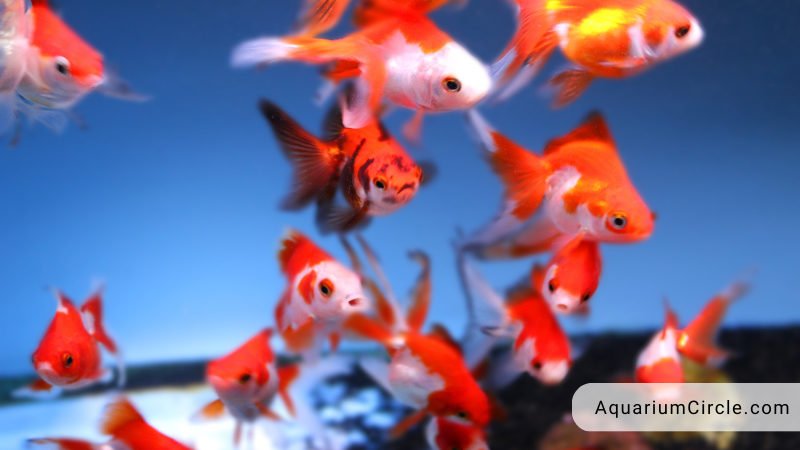
Fantail goldfish come in a variety of colors and patterns, making them a popular choice among aquarium hobbyists. Some of the most common colors include red, orange, yellow, white, and black. However, fantail goldfish can also come in shades of blue, green, brown, and even purple, depending on their genetic makeup.
In addition to their solid coloration, fantail goldfish can also have a variety of patterns, such as calico, speckled, or variegated. Some may have patches of color on their fins or bodies, while others may have stripes or spots.
The exact coloration and pattern of a fantail goldfish can be influenced by a variety of factors, including genetics, diet, and living conditions. For example, providing a high-quality diet that includes a variety of nutrients can help to enhance the coloration of a goldfish. Additionally, a healthy and stress-free environment can help to bring out the best in a goldfish’s colors.
Fantail goldfish body shape
Like other goldfish, Fantail goldfish also has its own characteristics in appearance so that the owner can easily recognize it, one of which is the body shape.
Fantail goldfish have a distinctive body shape that sets them apart from other types of goldfish. Their body is short and rounded, with a pronounced belly that gives them a slightly egg-shaped appearance. Their tail is double-lobed and fans out behind them, which gives them their name.
This body shape is the result of selective breeding, which has been used to create the distinctive appearance of the fantail goldfish. Over time, breeders have worked to accentuate the rounded body and double-lobed tail, as well as the smooth, streamlined appearance of the fish. This has resulted in a fish that is not only visually striking but also graceful and agile in the water.
Fantail goldfish fin
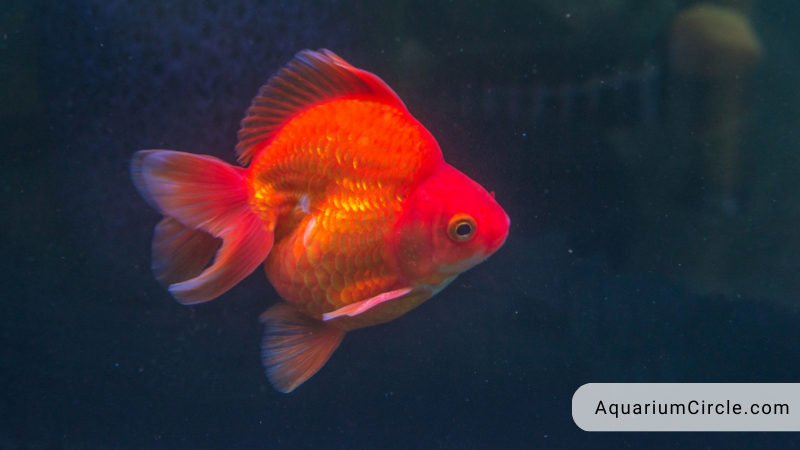
Fantail goldfish have a number of distinctive fins that add to their unique appearance. These include their double-lobed tail, as well as their dorsal fin, pectoral fins, and anal fin.
- The double-lobed tail of a fantail goldfish is perhaps its most distinctive feature. This tail is broad and rounded, with two lobes that spread out to either side of the fish’s body. The tail is held erect and should have a smooth, flowing appearance when the fish is swimming.
- The dorsal fin of a fantail goldfish is located on its back, towards the center of its body. It is typically triangular in shape and may be held erect or slightly folded over, depending on the fish’s mood.
- The pectoral fins of a fantail goldfish are located on either side of its body, towards the front. These fins are used to help the fish maintain its balance and direction in the water, as well as to assist in swimming.
- The anal fin of a fantail goldfish is located on its underside, towards the back of its body. It is typically small and triangular in shape, and is used for steering and stability in the water.
When selecting fantail goldfish for your aquarium, it’s important to look for individuals with well-proportioned and healthy fins. A fish with damaged or frayed fins may be a sign of poor health or environmental stress, so it’s important to choose fish that appear healthy and strong. With proper care and attention, fantail goldfish can thrive and make a beautiful addition to any aquarium or pond.
Fantail Goldfish Lifespan
Fantail goldfish have an average lifespan of 10-15 years, although with proper care and a healthy environment, some individuals can live for up to 20 years or more. This makes them a long-lived and rewarding addition to any aquarium or pond.
Here are some fun facts about the lifespan of fantail goldfish:
- The oldest known goldfish on record lived to be 43 years old! This impressive feat was achieved by a goldfish named Tish, who lived in the UK and was recognized by the Guinness World Records as the oldest goldfish in captivity.
- Goldfish have been kept as pets for over a thousand years, and have been selectively bred to produce a wide range of colors, patterns, and body shapes.
- The lifespan of a fantail goldfish can be influenced by a variety of factors, including genetics, diet, and living conditions. Providing a healthy and stress-free environment, as well as a balanced and nutritious diet, can help to promote healthy growth and development and increase their lifespan.
- The metabolism of a goldfish is influenced by temperature, and they have been known to live longer in cooler water temperatures (around 68-72 degrees Fahrenheit).
- The size of a goldfish can also influence their lifespan. Overcrowding can lead to stress, poor water quality, and disease, all of which can shorten a goldfish’s lifespan.
Fantail Goldfish Care Guide: Tank Maintenance, Water Conditions…
Tank size and environment
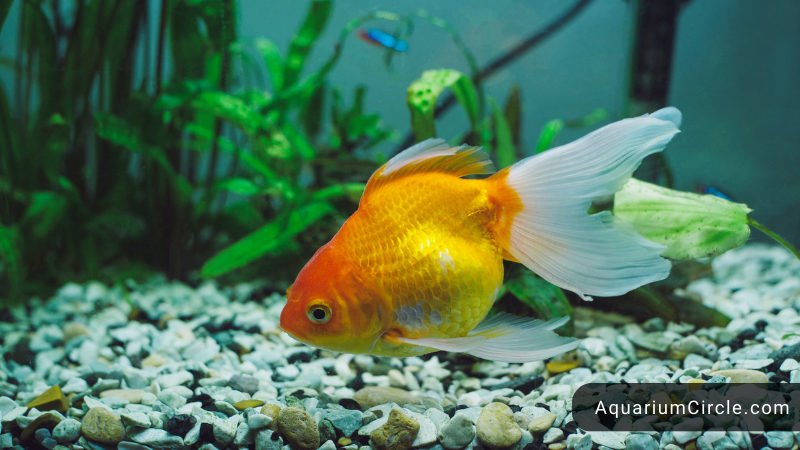
When it comes to choosing a suitable goldfish tank size for fantail, there are a number of factors to consider. Fantail goldfish can grow to be quite large, and they require plenty of swimming room to stay healthy and active. Here’s what you need to know about choosing a suitable tank size for your fantail goldfish:
- Goldfish need plenty of space to swim: As active swimmers, fantail goldfish require a lot of space to move around in. A small tank can quickly become crowded and stressful for these fish, which can lead to health problems and a shorter lifespan.
- Larger tanks are generally better: For a single fantail goldfish, a tank size of at least 20 gallons is recommended. If you plan to keep multiple goldfish, a larger tank is needed to provide enough space for them to swim and establish their own territories. A good rule of thumb is to provide at least 10 gallons of water per goldfish.
- Filtration is important: In addition to a suitable tank size, a good filtration system is essential for maintaining water quality and keeping your fish healthy. Goldfish produce a lot of waste, and without adequate filtration, the water can quickly become contaminated and harmful to the fish.
- Consider the dimensions of the tank: While the total volume of water in the tank is important, the dimensions of the tank can also influence how well your fish are able to swim and interact. A long, rectangular tank is generally better than a tall, narrow tank, as it provides more swimming room and better water circulation.
- Provide plenty of hiding places: While they are social and active, fantail goldfish need places to hide and rest as well. Adding plants, rocks, and other decorations to the tank can help create a more natural and stimulating environment for your fish.
In summary, a suitable tank size for fantail goldfish should be large enough to provide plenty of swimming room, with a minimum tank size of 20 gallons recommended for a single fish. Adequate filtration and a variety of hiding places should also be provided to keep your fish healthy and happy. By providing a suitable tank environment, you can help your fantail goldfish thrive and enjoy a long and rewarding life.
See also: 40 Gallon Goldfish Tank – 5 Important Notes You Should Know
Water quality and filtration
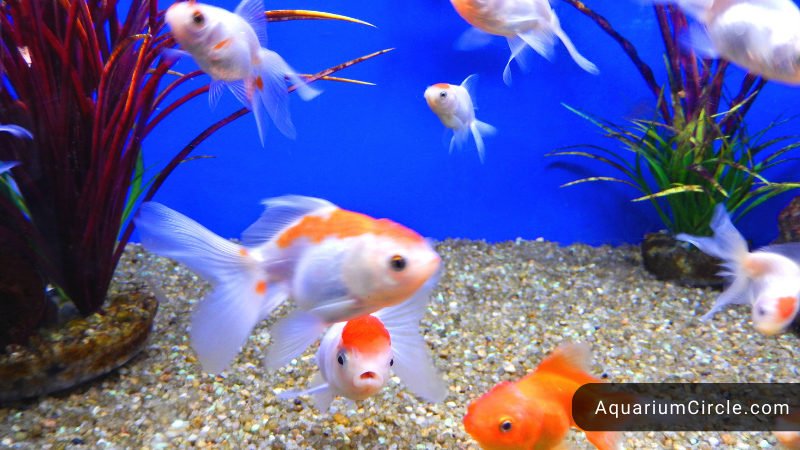
Maintaining good water quality and proper filtration is critical for the health and well-being of fantail goldfish. Goldfish are known to produce a large amount of waste, which can quickly lead to high levels of ammonia and other harmful substances in the water. Here’s what you need to know about water quality and filtration for your fantail goldfish:
- Ammonia and nitrite are toxic to fish: Ammonia is produced by fish waste, while nitrite is a byproduct of the breakdown of ammonia by beneficial bacteria. High levels of ammonia and nitrite can cause stress, illness, and even death in fish. In order to maintain a healthy environment for your fantail goldfish, it’s important to keep ammonia and nitrite levels as close to zero as possible.
- Filtration helps remove waste: A good filtration system is essential for removing excess waste from the water and promoting the growth of beneficial bacteria. A filter should be chosen based on the size of the tank and the number of fish being kept. Generally, a filter should be capable of cycling the entire volume of water in the tank at least 3-5 times per hour.
- Regular water changes are important: Even with a good filtration system, regular water changes are still necessary to keep ammonia and nitrite levels in check. A general rule of thumb is to change 10-20% of the water in the tank every week. Be sure to use a water conditioner to remove chlorine and other harmful chemicals from tap water before adding it to the tank.
- Test water regularly: In order to monitor the water quality in your tank, it’s important to test the water regularly using a water test kit. This will allow you to check ammonia, nitrite, nitrate, and pH levels and make adjustments as needed.
- Avoid overfeeding: Overfeeding is a common problem in goldfish tanks, and uneaten food can quickly lead to excess waste and poor water quality. A good rule of thumb is to feed your fantail goldfish only as much as they can eat in 2-3 minutes, once or twice per day.
What Are Good Tank Mates For Fantail Goldfish?
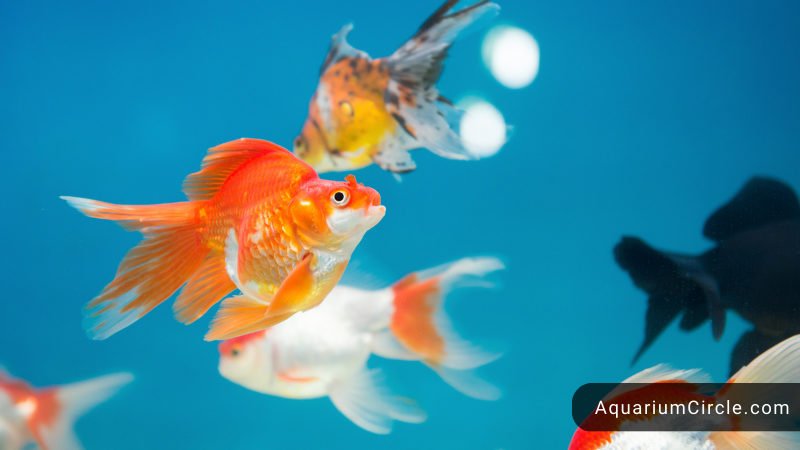
When it comes to selecting tank mates for your fantail goldfish, it’s important to choose fish that have similar water temperature and pH requirements. It’s also important to consider the size and temperament of the other fish to ensure that they are compatible with your fantail goldfish. Here are some good tank mates for fantail goldfish:
- Other goldfish: Other goldfish make great tank mates for fantails as they have similar temperature and pH requirements. However, it’s important to make sure that the tank is large enough to accommodate multiple goldfish and that they are not overcrowded.
- White Cloud Mountain Minnows: These small, peaceful fish are great tank mates for fantail goldfish. They are active swimmers and add a lot of color to the tank.
- Corydoras catfish: These small catfish are peaceful and will not bother your fantail goldfish. They also help keep the tank clean by eating leftover food and debris.
- Plecos: Plecos are another type of catfish that make good tank mates for fantail goldfish. They are known for their ability to eat algae and help keep the tank clean.
- Zebra Danios: These active fish are great swimmers and can help liven up the tank. They are also peaceful and won’t bother your fantail goldfish.
See also: Two Goldfish In A Tank: Did You Know Which Is The Ideal Size For Their Health?
It’s important to note that not all fish are compatible with fantail goldfish, and some fish may even pose a threat to their health and well-being. For example, aggressive fish like cichlids or bettas should not be kept with fantail goldfish, as they may attack or stress them out. It’s always a good idea to do your research and consult with an experienced fishkeeper before introducing new fish to your fantail goldfish tank.
Fantail Goldfish Diet
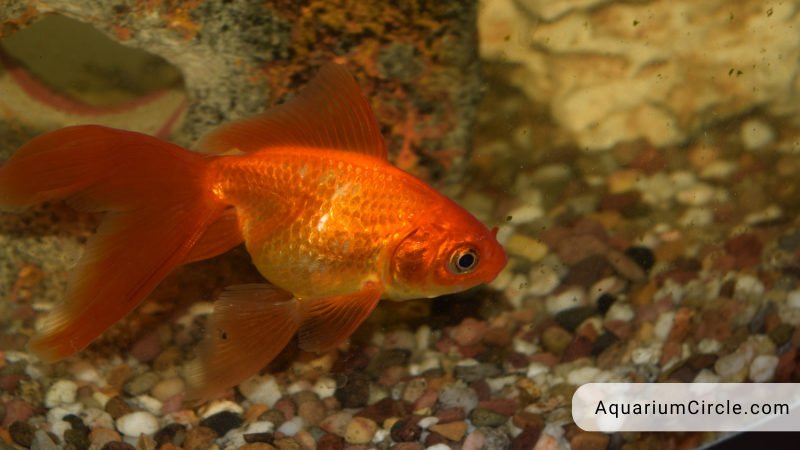
Feeding fantail goldfish a balanced diet is important to ensure their health and vitality. Here are some guidelines for feeding your fantail goldfish:
- Flake or pellet food: High-quality flake or pellet food is a staple of a fantail goldfish’s diet. Look for a food specifically designed for goldfish, as it will contain the appropriate balance of nutrients.
- Fresh or frozen foods: In addition to flake or pellet food, you can supplement your fantail goldfish’s diet with fresh or frozen foods such as bloodworms, brine shrimp, or daphnia. These foods are a great source of protein and can add variety to your goldfish’s diet.
- Vegetables: Goldfish also enjoy eating vegetables such as peas, zucchini, and spinach. These foods are a good source of fiber and can help keep your goldfish’s digestive system healthy.
- Variety is important: While flake or pellet food is a good staple food for fantail goldfish, it’s important to provide a varied diet. Including fresh or frozen foods, such as bloodworms, brine shrimp, and daphnia, can add valuable nutrients and help prevent boredom in your fish.
- Vegetables can be beneficial: As mentioned earlier, vegetables such as peas, zucchini, and spinach are a good source of fiber and can help keep your goldfish’s digestive system healthy. You can blanch or steam these vegetables before feeding them to your fish to make them easier to digest.
- Avoid feeding them human food: While it may be tempting to give your fantail goldfish some of your leftover food, it’s important to avoid doing so. Many human foods contain additives, preservatives, or spices that can be harmful to fish. Stick to feeding them a diet specifically designed for goldfish.
- Avoid overfeeding: Overfeeding is a common problem with goldfish, and can lead to obesity and other health issues. A good rule of thumb is to feed your fish small amounts of food two or three times a day, and remove any uneaten food after a few minutes. This can also help prevent poor water quality in your tank.
- Consider feeding in different locations: Fantail goldfish are known to be slow swimmers, and can sometimes have trouble competing with faster fish for food. Consider feeding them in different locations in the tank to ensure that each fish has a chance to eat.
See also: How Long Can Goldfish Go Without Food In Your Tank Or Pond?
It’s also important to note that fantail goldfish have a tendency to gulp air at the surface of the water, which can cause digestive problems. To avoid this, make sure that you have well-oxygenated the water in the goldfish tank and avoid feeding your goldfish immediately after a water change. Providing your fantail goldfish with a balanced diet and avoiding overfeeding can help ensure their health and longevity.
Can we feed our fantail goldfish live food?
Yes, you can feed live food to fantail goldfish, but there are some things you should keep in mind.
Live food, such as brine shrimp, bloodworms, and daphnia, can provide a great source of protein and nutrition for your fantail goldfish. They can also add variety to your goldfish’s diet, which can help keep them interested and engaged in their environment.
However, there are some risks associated with feeding live food to your goldfish. For example, live food can carry diseases or parasites, which can be harmful to your fish. Additionally, live food can introduce harmful bacteria to your aquarium, which can lead to poor water quality and health problems for your fish.
If you decide to feed your fantail goldfish live food, it’s important to choose a reputable supplier and ensure that the live food is healthy and disease-free. You should also avoid overfeeding your fish with live food, as this can cause digestive problems and poor water quality.
Overall, feeding live food to your fantail goldfish can be a good option, as long as you take the appropriate precautions and ensure that your fish are getting a balanced diet.
How To Breed Fantail Goldfish?
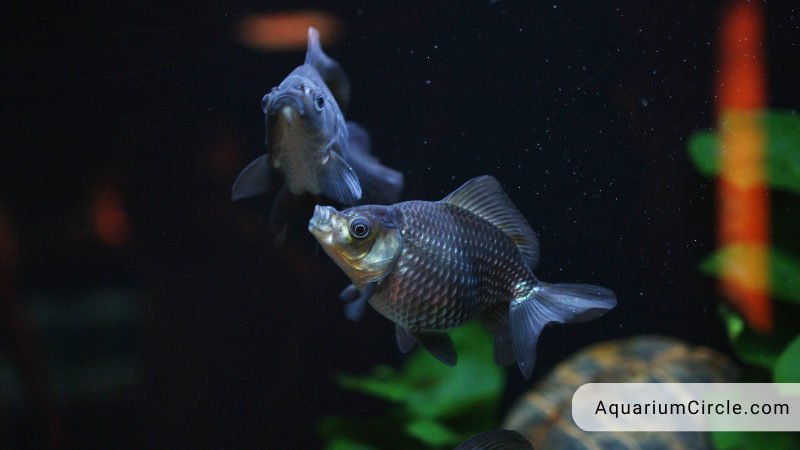
Breeding fantail goldfish can be a rewarding experience for fishkeepers, but it requires some preparation and care. Here are the steps to breed fantail goldfish:
- Select healthy breeding pairs: The first step in breeding fantail goldfish is to choose a healthy breeding pair. Look for fish that are in good health, have vibrant colors, and are free from deformities or genetic defects.
- Prepare a breeding tank: To breed fantail goldfish, you’ll need to separate breeding tank and the the tank conditions should meet some requirements, that is at least 20 gallons in size. The tank should be well-filtered, and the water should be kept at a temperature between 65 and 75 degrees Fahrenheit.
- Condition the breeding pair: To encourage breeding, you’ll need to condition the breeding pair by feeding them a varied diet of high-quality foods, such as live or frozen brine shrimp, bloodworms, and daphnia. You can also raise the temperature of the water and gradually reduce the lighting in the tank to simulate the change of seasons.
- Introduce the breeding pair: Once the breeding pair is in good health and conditioned for breeding, you can introduce them to the breeding tank. You may notice the male fantail chasing the female around the tank, which is a sign that they are exploring the tank together and are ready to spawn.
- Observe and monitor the breeding process: Once the breeding pair has spawned, the male will fertilize the eggs and then both parents will guard and tend to the eggs all over the tank. It’s important to monitor the breeding process carefully and ensure that the water quality is maintained at a high level. You may also need to provide additional aeration and filtration during this time.
- Raise the fry: Once the eggs hatch, you’ll need to carefully raise the fry by providing them with small, frequent feedings of high-quality foods. You can start with commercially available fry food or freshly hatched brine shrimp. It’s important to keep the water quality high and perform frequent water changes to ensure the fry’s health.
Breeding fantail goldfish requires some knowledge and care, but it can be a rewarding experience for fishkeepers who are up to the task.
Will the parents eat the eggs?
Fantail goldfish are not generally known to eat their own eggs. In fact, once the breeding pair has spawned, both the male and female will typically work together to protect and care for the eggs.
However, there are some circumstances where the parents may accidentally or intentionally eat the eggs. For example, if the parents are stressed or not provided with enough food, goldfish will eat the eggs out of desperation. Additionally, if the breeding tank is overcrowded, the parents may not have enough space to properly care for the eggs and may end up eating them.
To prevent the parents from eating the eggs, it’s important to ensure that the breeding tank is clean, well-maintained, and appropriately sized for the breeding pair. You should also provide the breeding pair with plenty of high-quality food and ensure that they are not under any undue stress. By providing a healthy and stress-free environment, you can increase the likelihood that the eggs will hatch successfully and the fry will survive.
Health Issues: What Are Some Common Disease In Fantail Goldfish?
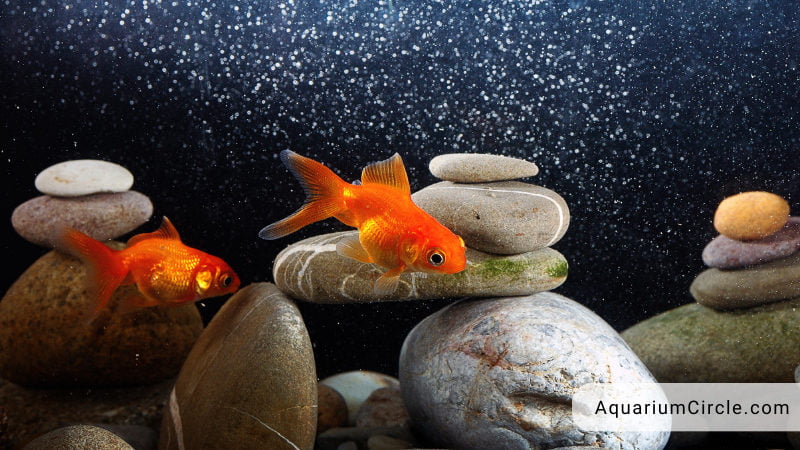
Fantail goldfish, like all fish, are susceptible to a variety of diseases. Here are some of the most common diseases that can affect fantail goldfish:
- Ich: Ich is a common parasitic disease that can affect any species of fish, including fantail goldfish. Symptoms include white spots on the body and fins, scratching against objects in the tank, and increased mucus production. Ich can be treated with a variety of over-the-counter medications, but it’s important to remove any activated carbon from the tank during treatment.
- Dropsy: Dropsy is a condition that causes the fish to appear bloated and swollen, with scales that may appear raised or pinecone-like. Dropsy can be caused by a variety of factors, including poor water quality, stress, and bacterial infections. Treatment may involve antibiotics, water changes, and improving the overall health of the fish.
- Swim bladder disorder: Swim bladder disorder is a condition that affects the fish’s ability to regulate its buoyancy in the water. Symptoms may include floating to the surface or sinking to the bottom of the tank, and difficulty swimming. Swim bladder disorder can be caused by a variety of factors, including overfeeding and bacterial infections. Treatment may involve fasting the fish and providing a high-fiber diet.
- Fin rot: Fin rot is a bacterial infection that can cause the fins of the fish to become ragged and frayed. It can be caused by poor water quality, physical damage to the fins, or other stressors. Treatment may involve antibiotics, water changes, and improving the overall health of the fish.
- Velvet: Velvet is a parasitic disease that causes the fish to have a velvety, yellowish appearance. Symptoms may include rapid breathing, loss of appetite, and rubbing against objects in the tank. Velvet can be treated with over-the-counter medications.
- Fungus: Fungal infections can cause white, cottony growths on the body and fins of the fish. Fungal infections are often caused by poor water quality or physical damage to the fish. Treatment may involve antifungal medications and improving water quality.
- Columnaris: Columnaris is a bacterial infection that can cause white or gray patches on the body and fins, as well as rapid breathing and loss of appetite. Columnaris is often caused by poor water quality, stress, or physical damage to the fish. Treatment may involve antibiotics and improving water quality.
- Parasites: Various parasites, such as anchor worms, fish lice, and flukes, can affect fantail goldfish. Symptoms may include visible parasites on the body of the fish, redness, and irritation. Treatment may involve medication specifically targeted to the type of parasite.
Are Fantail Goldfish Suitable For Beginners?
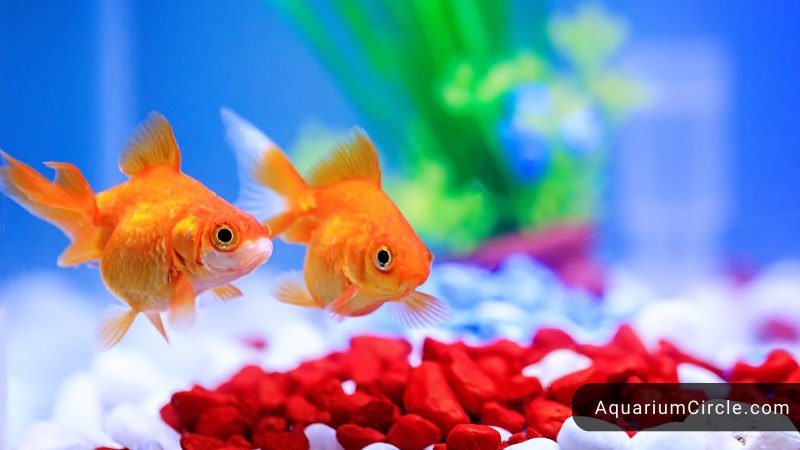
Of course, fantail goldfish can be a good choice for beginner fish keepers. Here are a few reasons why:
- Hardiness: Fantail goldfish are hardy fish and can tolerate a range of water conditions, making them more forgiving for beginner fish keepers who may not have as much experience maintaining a stable aquatic environment.
- Low Maintenance: Fantail goldfish do not require a lot of maintenance and can be relatively easy to care for. They are generally not picky eaters and can thrive on a variety of fish foods.
- Visual Appeal: Fantail goldfish are beautiful fish with their distinctive body shape and attractive coloration, making them a popular choice for many fish keepers.
That being said, it’s important to keep in mind that even hardy fish like fantail goldfish still require a certain level of care and attention to ensure their health and well-being. It’s important to properly research and understand the needs of your fish before bringing them home, including proper tank size, water quality requirements, and appropriate tank mates. With proper care, fantail goldfish can make a wonderful addition to any aquarium, even for beginner fish keepers.
Video About Fantail Goldfish
FAQs
What is the lifespan of a fantail goldfish?
antail goldfish can live up to 10-15 years with proper care and maintenance.
Can fantail goldfish live in a pond?
Yes, fantail goldfish can live in an outdoor pond as long as the pond is large enough and has good water quality.
What should I feed my fantail goldfish?
A well-balanced diet for fantail goldfish can consist of high-quality commercial flakes or pellets, live or frozen foods such as brine shrimp or bloodworms, and fresh vegetables like peas or spinach.
Can fantail goldfish live with other fish?
Fantail goldfish can live with other peaceful, cold-water fish that have similar water and space requirements. However, it is important to avoid aggressive or fin-nipping fish that may harm or stress the fantail goldfish.
References

Annette M. Chaney is an experienced marine biologist with over 20 years of experience as an aquarist and fishkeeper. She started her first aquarium at a young age, filling it with frogs and goldfish obtained from the ten-cent pet store.
Annette grew up caring for and breeding African Cichlids, which led to a hobby in high school that doubled as a profitable means. Attending Reed College gave her time to solidify herself as an accomplished aquarium caretaker with an eye for sales. After that, from 2009 – 2013, she studied at Roger Williams University – one of the most prestigious universities for Aquaculture and Aquarium in USA. She is the founder of AquariumCircle since 2010.
